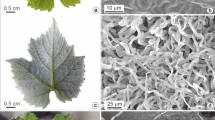Abstract
Changes in different biochemical parameters like total phenolic content, protein pattern, polyphenol oxidase, peroxidase and isozymes of peroxidase were compared in sterility mosaic resistant (Hy3C) and susceptible (Type-21) pigeonpea varieties at different growth stages both under inoculated and uninoculated conditions. Resistant variety was characterized by the presence of specific isoperoxidase and proteins but only little difference was recorded between resistant and susceptible variety with respect to preformed or induced total phenolics and peroxidase activity. The activity of polyphenol oxidase increased substantially in susceptible variety following infection. Role of these changes is discussed in relation to disease resistance.
Similar content being viewed by others
Abbreviations
- PSMV:
-
Pigeonpea sterility mosaic virus
- PPO:
-
polyphenol oxidase
- PO:
-
peroxidase
References
A O A C (1965)Official Methods of Analysis 10th edition (Washington: Association of Oficial Agricultural Chemists) p. 657.
Barbara, D. J. and Wood, R. K. S. (1972)Physiol. Plant Pathol.,2, 167.
Cabanne, F., Scalla, R. and Martin, C. (1971)J. Gen. Virol.,11, 119.
Davis, B. J. (1964)Ann. N.Y. Acad. Sci.,121, 404.
Fric, F. (1976) InPhysiological Plant Pathology (eds R. Heitefuss and P. H. Williams) (Berlin: Springer-Verlag) Vol. 4. p. 617.
Kosuge, T. (1969)Annu. Rev. Phytopathol.,7, 195.
Kuc, J., Henze, R. R., Ulistrup, A. J. and Quanchenbush, F. W. (1956)J. Am. them. Soc.,78, 3123.
Loebenstein, G. (1972)Annu. Rev. Phylopathol.,10, 177.
Nene, Y. L. (1980)A world list of pigeonpea (Cajanus cajan (L.) Millsp.) and chickpea(Cicer arietinum L.) Pathogens., Pulse Pathology Progress Report-8. ICRISAT, Patancheru.
Nene, Y. L. and Rathi, Y. P. S. (1972)A survey of Pulse Diseases in Uttar Pradesh (ed. Y. L. Nene). (Pantnagar: G. B. Pant University of Agriculture and Technology) pp. 157–159.
Nene, Y. L. and Reddy, M. V. (1976)Plant Dis. Rep.,60, 1034.
Retig, N. (1974)Physiol. Plant Pathol.,4, 145.
Sela, I. (1981)Adv. Virus Res.,26, 201.
Suseno, H. and Hampton, R. E. (1966)Phytochemistry.5, 819.
Tripathi, R. K., Vohra, K. and Beniwal, S. P. S. (1975)Indian J. Exp. Biol.,13, 513.
Author information
Authors and Affiliations
Additional information
Research Publication no. 3949 G.B. Pant University of Agriculture and Technology, Pantnagar, India.
Deceased.
Rights and permissions
About this article
Cite this article
Rathi, Y.P.S., Bhatt, A. & Singh, U.S. Biochemical changes in pigeonpea (Cajanus cajan (L.) Millsp.) leaves in relation to resistance against sterility mosaic disease. J. Biosci. 10, 467–474 (1986). https://doi.org/10.1007/BF02900507
Received:
Revised:
Published:
Issue Date:
DOI: https://doi.org/10.1007/BF02900507




